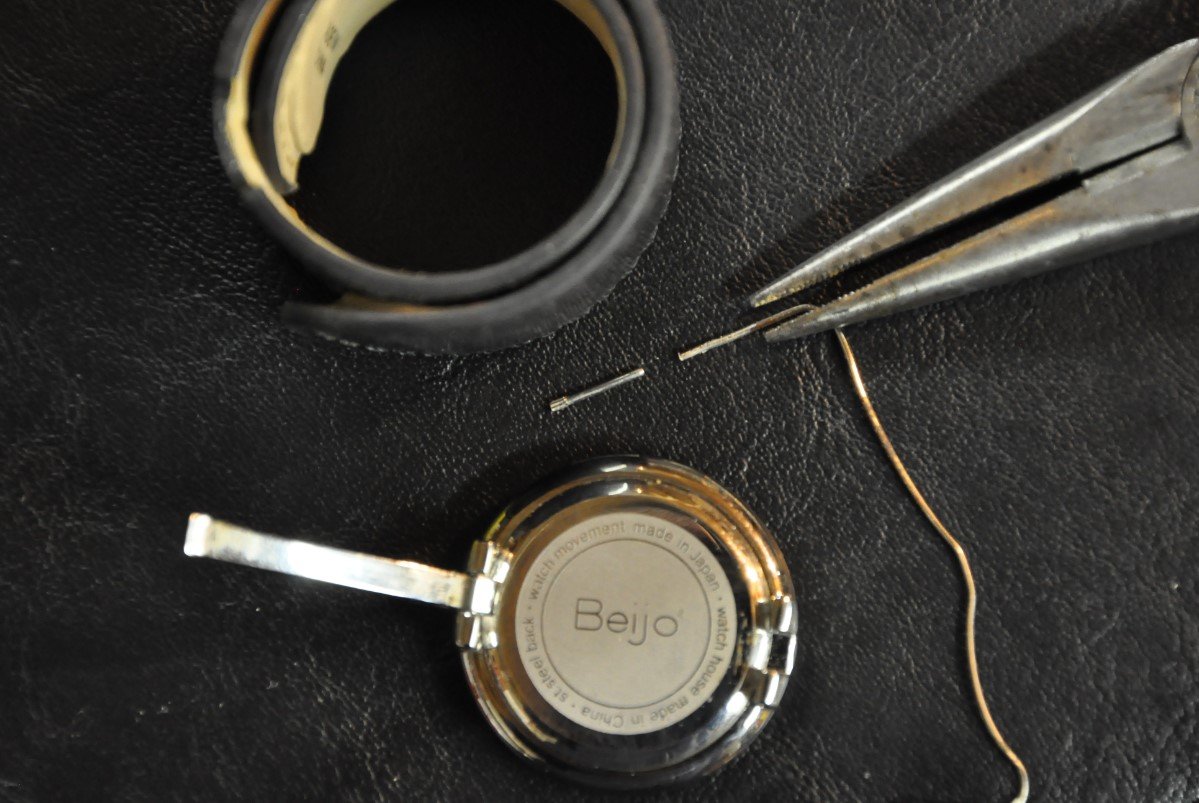Did you know that nearly 80% of people who own watches struggle with removing the watch back when changing batteries or adjusting the time? If you find yourself in this predicament, fret not! Whether you’re a novice watch enthusiast or just looking to save some money on trips to the jeweler, mastering this skill is invaluable. Stay tuned as we guide you through step-by-step instructions and insider tips, utilizing a removal tool, to demystify the process of removing a watch back effortlessly.

Understanding watch back types
Snap-Off Watch Backs
Snap-off watch backs are common in watches that do not require special tools like a rubber ball or thumbnail for removal. These backs can be taken off by gently prying them open using a case back opener or a specialized knife. The key is to apply even pressure around the edges until the back pops off.
Removing snap-off watch backs is relatively easy and doesn’t require advanced skills or tools, making it suitable for beginners. However, these types of watch backs may not provide as much water resistance as screw-down or notched backs.
Screw-Down Watch Backs
Screw-down watch backs feature small screws that secure the back to the case, providing excellent water resistance. To remove this type of back, you will need a precise tool like a case wrench with matching tips to unscrew and lift off the back carefully.
While screw-down watch backs offer superior water resistance compared to snap-off ones, they require specific tools for removal. This type of watch back is commonly found in diving watches due to its ability to prevent water from entering the timepiece.
Notched Watch Backs
Notched watch backs have small indentations around their edges that correspond with slots on the case’s rim. To remove a notched back, you will need a case wrench with adjustable pins that fit into these indentations securely. By turning counterclockwise while applying gentle pressure downward, you can unlock and lift off the notched back.
Notched watch backs strike a balance between ease of removal and water resistance capabilities. They offer better protection against moisture compared to snap-off but may be slightly less resistant than screw-down varieties.
Tools needed for watch back removal
Essential Tools
To remove a watch back, you need specific tools to make the process smooth and safe. A case opener is crucial for popping off snap-off watch backs, while a case knife helps with prying open stubborn backs. A case wrench is handy for screw-back watches, providing the necessary torque to twist them open.
Investing in these essential tools ensures that you can tackle different types of watch backs efficiently and without causing any damage. For instance, using a case opener designed for snap-off backs prevents scratches or dents on the watch casing during removal.
Quality tools are not only easier to work with but also ensure that you don’t accidentally harm your timepiece while trying to access the internal components of your watch.
Importance of Quality Tools
Having the right tools when removing a watch back is like having the correct key to unlock a door – it makes everything much simpler and safer. Imagine trying to unscrew something with an ill-fitting tool; it’s frustrating and risks damaging your precious timepiece.
By investing in quality tools such as a case holder that secures your watch in place during removal, you can avoid unnecessary mishaps like slipping and scratching your watch’s surface. These tools are designed to provide precision and stability, making the entire process more manageable even if you’re new to handling watches.
Preparing your workspace
Find
Choose a clean, well-lit area to remove the watch back. This will help you see clearly and avoid losing any small parts.
Ensure the place is free from clutter to prevent losing tiny screws or components essential for reassembly.
Lay down
Protect your watch by laying a soft cloth or mat on a flat surface before starting. This prevents scratches and damage during the removal process.
A soft cloth also provides a cushioned surface for delicate watches, safeguarding them against accidental bumps or falls.
Gather all necessary tools
Before you begin removing the watch back, gather all required tools in one place. Having everything within reach saves time and prevents interruptions during the process.
Tools like case openers, tweezers, and magnifying glasses are crucial for safely opening different types of watch backs without causing damage.
Techniques for snap-off back removal
Using a Case Knife or Specialized Tool
To remove a snap-off watch back, you can use a case knife or a specialized case opener tool. Carefully insert the blade of the tool into the small gap between the case and the back. Then, gently pry it open to release the back from the watch.
Snap-off backs are designed to be removed easily with minimal effort. By using a case knife or specialized tool, you can effectively unlock and remove these types of watch backs without causing any damage. Remember not to apply excessive force when prying open the back as it could lead to potential harm.
Safety Precautions
When removing a snap-off watch back, always prioritize safety measures. Avoid using excessive force that may result in damaging your timepiece or causing injury. It’s crucial to handle tools carefully and with precision to prevent accidents during this process.
Methods for screw-down back removal
Using a case wrench
Screw-down backs necessitate a back removal tool like a case wrench. This tool has adjustable jaws that fit into the notches on the watch’s back. Align the jaws with the notches and turn counterclockwise to unscrew it. Apply even pressure while turning to prevent slipping or scratching.
A case wrench is essential for removing screw-down backs as it provides a secure grip, preventing damage to the watch drive recesses. When using this tool, ensure that you align its jaws precisely with the grooves on the back of your watch. Turning counterclockwise allows you to loosen and remove the back effectively without causing any harm.
Ensuring proper technique
To successfully remove a screw-down back, remember always to turn counterclockwise using steady pressure. This method prevents slippage and potential scratches on your timepiece. By utilizing a case wrench correctly, you can effortlessly access and maintain your watch’s internal components without causing any damage.
Handling a watch with a notched back
Using a Case Wrench
To remove a watch back with notches, you need to use a case wrench. These notched backs are commonly found on specific brands or models of watches. The case wrench has matching notches that grip the watch back securely for removal. Be cautious when handling watches with notched backs as they tend to be more delicate and can easily get damaged.
A case wrench is essential for this task because it provides the right leverage needed to unscrew the watch back effectively. To start, ensure that your case wrench matches the notches on the watch back perfectly. Insert the tips of the case wrench into the notches and apply gentle pressure in a counterclockwise direction to loosen and remove the backing piece.
Taking Extra Care
When dealing with watches featuring notched backs, it’s crucial to exercise extra caution due to their fragile nature. Mishandling these types of timepieces can result in damage or scratches on both the front and back cases. Therefore, always make sure you have a firm grip on both pieces before attempting to twist off the watch backing.
Using tools like finger cots can provide additional protection against accidental slips or scratches while working on removing notched backs from watches. Remember always to turn in a counterclockwise movement when using your case wrench so that you don’t inadvertently tighten instead of loosening it.
Tips for avoiding damage during removal
Using the right tools
When removing a watch back, it’s crucial to use the correct tools. For instance, if you have a screw-down case back, using a removal tool designed for that specific type can prevent scratches or dents. Utilizing improper tools like scissors can lead to irreversible damage.
Using the appropriate tool ensures that you apply even pressure when removing the watch back. This helps in preventing any accidental slips or excessive force that could potentially harm the case or internal components.
Being gentle and patient
One of the most important tips to remember is to avoid applying too much force. Excessive pressure while trying to remove the watch back can result in damaging not only the case but also delicate internal parts. If you encounter resistance, it’s essential to pause and reassess your technique.
Being gentle and patient throughout the process is key. Slow, steady movements are more effective than rushed actions that might lead to unintended consequences such as scratches or misalignment of components.
Reassembling the watch back properly
Clean and Align
After successfully removing the watch back, it’s crucial to ensure that it is clean and free from any debris or dust. This step helps prevent any interference with the proper functioning of the watch components. Aligning the back with the case correctly is essential. It ensures that all parts fit together seamlessly, maintaining the watch’s integrity.
To achieve this alignment, make sure any gaskets or seals are in their correct positions before reassembling. These components play a vital role in maintaining the watch’s water resistance and overall durability. By ensuring they are properly positioned, you help maintain these important functions.
Secure Fit
When putting the watch back into place, use gentle pressure to snap or screw it securely onto the case. Applying too much force can damage delicate internal mechanisms within your timepiece. A secure fit not only protects these intricate parts but also maintains the overall aesthetics of your watch.
Maintenance tips after watch back removal
Cleaning the Watch Case and Back
After successfully removing the watch back, it’s crucial to clean both parts properly. Use a soft cloth to wipe away any dust or dirt that may have accumulated. For more stubborn stains, consider using a specialized cleaning solution recommended for watches. This step ensures that your timepiece remains in top condition and free from any debris that could affect its performance.
To maintain the integrity of your watch, pay close attention to the cleanliness of both the case and back. A clean watch is not only aesthetically pleasing but also helps prevent potential damage caused by dirt buildup over time. By regularly cleaning these components, you can prolong the lifespan of your watch and keep it looking as good as new.
Inspecting and Replacing Gaskets or Seals
Inspecting and replacing worn-out gaskets or seals is essential after removing the watch back. These components play a critical role in maintaining the water resistance of your timepiece. Over time, gaskets can wear out due to exposure to various elements or general wear and tear. By checking them regularly, you can ensure that your watch remains protected from water damage.
Regularly inspecting gaskets allows you to identify any signs of wear early on before they compromise your watch’s water resistance capabilities further. If you notice any deterioration or damage, promptly replace these seals with new ones recommended by the manufacturer. This simple maintenance task can go a long way in preserving your watch’s functionality.
Closing Thoughts
You’ve now mastered the art of removing a watch back like a pro. With the right tools, techniques, and a steady hand, you can tackle any type of watch back removal with confidence. Remember, patience is key in this process. Take your time, follow the steps diligently, and soon you’ll be able to remove and reassemble watch backs effortlessly.
So, go ahead, grab your tools, and give it a try! Practice makes perfect, and before you know it, you’ll be a watch back removal expert. Don’t hesitate to dive in and start honing your skills. Happy tinkering!
Frequently Asked Questions
How do I identify the type of back my watch has?
To determine your watch back type, observe if it has notches for a tool (snap-off), screws visible on the back (screw-down), or a smooth surface with no visible openings (notched). Understanding this helps in selecting the right removal technique.
What tools are essential for removing a watch back?
Key tools include a case opener knife or wrench, case press, screwdriver set, and non-slip mat. These tools aid in safely opening different types of watch backs without causing damage to the timepiece.
Can I remove a watch back without damaging it?
Yes, by following proper techniques and using suitable tools. Avoid excessive force, use gentle pressure when needed, and ensure you have identified the correct method based on your specific watch’s design to prevent any harm.
How can I reassemble my watch after removing the hinged caseback?
Carefully align the gasket or seal properly before placing the back cover. Use appropriate pressure to close it securely but avoid overtightening screws. Double-check if everything is aligned correctly to maintain water resistance and functionality.
Are there any post-removal maintenance tips for my watch?
After removing and reassembling the watch back, wipe off any fingerprints or dirt accumulated during handling. Inspect for dust particles that may have entered during removal and clean them out gently before wearing your timepiece again.



















